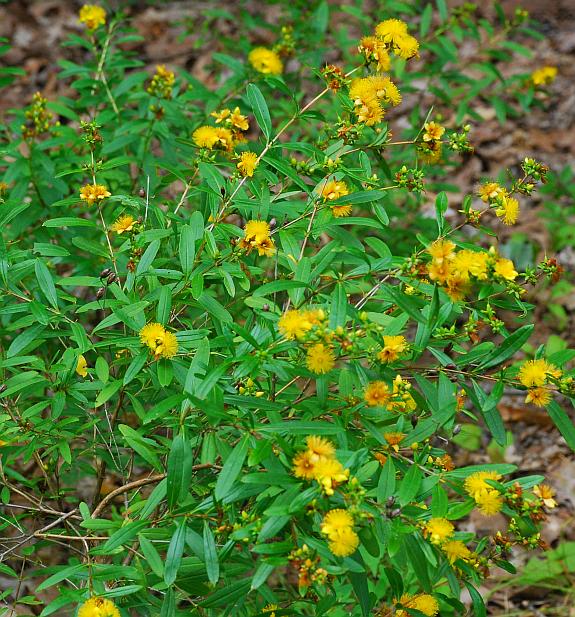Hypericum prolificum L.
Shrubby St. John's-Wort

Native
CC = 4
CW = 3
MOC = 67
© SRTurner
Hypericum prolificum L.Shrubby St. John's-Wort | |
 |
Native CC = 4 CW = 3 MOC = 67 |
© SRTurner |
|
Family - Hypericaceae Habit - Shrub to 2 m. Stems - Ascending, woody, multiple from the base, branching. Bark gray, smooth, usually peeling in thin strips or flakes, with an orange underlayer. Twigs angled or slightly ridged below each leaf, reddish brown, the older stems usually rounded but often with longitudinal lines below the leaves, tan to gray.
Leaves - Opposite, simple, sessile. Blades 10-75 mm long, 4-15 mm wide, narrowly oblong to narrowly elliptic-oblanceolate, rounded to bluntly pointed at the tip, sometimes with a minute, sharp point or a small notch at the tip, tapered or narrowed to a petiole-like base, the margins often somewhat rolled under at maturity, herbaceous to somewhat leathery in texture, with 1 main vein visible, the surfaces glabrous, lacking noticeable yellowish brown or black dots, lines, or streaks but occasionally with minute, faint, pale dots visible, the upper surface green, the undersurface pale green and often somewhat glaucous.
Inflorescence - Small clusters of mostly 3-7 flowers, often with an additional pair of flowers in the axils of the uppermost leaves. Flowers sessile or on short pedicels to 5mm long.
Flowers - Actinomorphic. Sepals 5, all similar in size and shape, 4-8 mm long, becoming somewhat enlarged at fruiting, obovate to oblanceolate or broadly to narrowly elliptic, lacking noticeable yellowish brown or black dots, lines, or streaks. Petals 5, 7-15 mm long, broadly oblanceolate to obovate, glabrous, yellow to orangish yellow, usually shed before fruiting. Stamens 150-500, the filaments not fused into groups. Ovary superior, ovoid, glabrous, incompletely 3-locular, the placentation more or less axile. Styles 3, free above the base, but erect and more or less appressed at flowering, persistent and usually separating somewhat as the fruit matures, the stigmas minute. Placentation axile.
Fruits - Capsules 7-14 mm long, ovoid to elliptic-ovoid or somewhat conical, widest below the midpoint, tapered to the beak, not lobed, circular to more commonly bluntly triangular in cross-section. Seeds numerous, 1.5-2.0 mm long, the surface with a network of fine ridges and pits, appearing inconspicuously longitudinally ribbed, dark brown to nearly black.
Flowering - June - September. Habitat - Upland forests, glade margins, streambanks, bluffs, fields. Sometimes cultivated. Origin - Native to the U.S. Lookalikes - Hypericum lobocarpum, which is rare in Missouri and found only in extreme southern portions of the state. Other info. - This species grows wild across much of Missouri, excluding the northwest quadrant of the state. Beyond Missouri it is found mostly in the central U.S. Midwest, and eastward nearly to the Atlantic Coast. It is recognized by its shrubby habit, leathery, shiny, opposite leaves, and numerous yellow pon-pom like flowers. It closely resembles H. lobocarpum, which can be distinguished by its longitudinally lobed carpels and fruits. Those of H. prolificum are more or less round in cross section, and contain three locules (see photo above). The plant is showy and takes well to cultivation, and is becoming increasingly popular for landscaping and in hedgerows. Photographs taken at Logan Creek, Reynolds County, MO., 7-3-04 (DETenaglia); also at LaBarque Creek Conservation Area, Jefferson County, MO, 7-18-2016 and 8-9-2021, and also of cuttings supplied by KBildner, 6-26-2023 (SRTurner). |